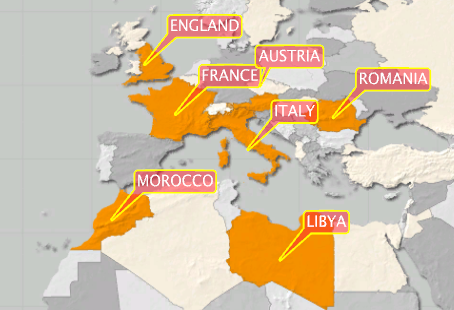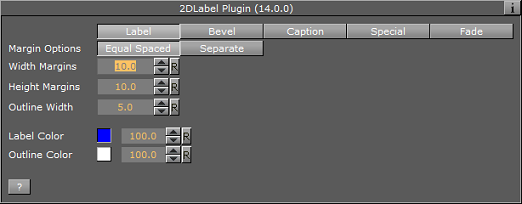
Viz World User Guide
Version 17.0 | Published January 24, 2018 ©
2D Label
![]()
The plugin can be found in the folder: Viz Artist 3: Built Ins -> Geom Plugins -> Maps.

The 2DLabel plugin is used for creating two dimensional labels on the map, based on labels received from the selected map or automatically generated labels generated by the Label Manager Plugin according to the map information received from the Navigator plugin.
Note: When adding a 2DLabel plugin to a container, a World Position plugin and an Alpha plugin will be added automatically to the same container. The Label Manager Plugin scene plugin has to be added manually to the scene when using the 2DLabel plugin without a Navigator plugin.
This plugin has five sections of parameters (GUI Options):
Label

-
Margin Options:
-
Equal Spaced: Uses equal spacing for the side margins and top/bottom margins.
-
Separate: Uses different margins for each side of the labels.
-
-
Width Margins, Left/Right Margins: Sets the margin between the sides of the text and the label background edges.
-
Height Margins, Top/Bottom Margins: Sets the margin between the top and bottom of the text and the label background edges.
-
Outline Width: Sets the width of the label’s background outline.
-
Label Color: Sets the color of the label’s background fill.
-
Outline Color: Sets the color of the label’s background outline.
Note: The numeric values next to the color parameters are the alpha values of the label and the label outline.
Note: The color palette effects only the selected color parameter (label or outline), and it will appear when one of the color parameter is selected. (Viz 3).
Bevel

-
Bevel: This parameter defines the bevel value of the label’s background corners.
-
Roundness: This parameter defines whether the background corners will be rounded or not.
-
Detail: Defines the quality of the label object (when a higher value is selected, more polygons will be used to build the label object).
-
Lock Aspect: When enabled (On), the bevel and roundness parameters will be applied to the corners of the label object equally. When disabled (Off), the bevel and roundness parameters will be applied to the corners using the object’s height and width ratio.
Caption

-
Pivot: Defines the label’s object shape and location in relation to the label’s geographic location:
-
Pointer: The label object includes a pointer going out of the label background and pointing at the label’s geographical position. When selected, additional parameters will be enabled: Width and Connection Bevel.
-
Outline: The label object has a rectangular shape and the outline of the shape is on the label’s geographical position.
-
Center: The center of the label is placed over the label’s geographical position.
-
Offset: The label is placed at the defined offset from the label’s geographical position.
-
Position: Used by Auto Street Labels to suggest a few possible locations for the label (positions along the street) so that Label Manager can pick one of them.
-
-
Width Type: Defines whether the (strap) width should change as the caption is moving away from the tip or stay fixed.
-
Width: Defines the width of the pointer’s base overlapping the label background. This parameter is only enabled when Pointer is selected.
-
Connection Bevel: Defines whether the area connecting between the pointer and the label background is to be rounded or sharp. This parameter is only enabled when Pointer is selected.
-
Rotate Labels: Defines whether labels, created in Viz (3D labels), will be rotated like the labels in World Map Editor or Map Editor Classic (WME). If set to Off, all labels will be displayed horizontally. If set to On, labels that were rotated in Map Editor will be rotated in Viz.
-
Caption Source: The options Default Position, WME Directions and Label Manager Presets include the properties described below.
Default Position
This will be used when adding labels in WME when no direction is selected.
-
Direction (deg): Sets the angle of the label in relation to its geographic position.
-
Distance (cm): Sets the distance of the label from its geographical position.
-
WME Offsets Distance: Enables the WME to offset the distance (default ON). When disabled (OFF) only the direction offsets from WME is used and the distance ignored.
WME Directions
This allows you to set and fine tune offsets for every direction available in WME. When selected, the labels will be placed as they were placed on the map in the Map Editor. When manually set inside WME they will always take priority over the presets and Default Position settings.
-
WME Compass Rose: Corresponds to the available directions inside the WME, as shown in the following image.

-
Direction Offset (Degrees): Values for fine-tuning the position of the label
-
Distance (Viz units): Distance offset for fine-tuning the position of the label
Label Manger Presets
When this is selected, the LabelManager plugin will use the defined presets to place the labels over the map. The LabelManager plugin will optimize the label position such that the labels will not overlap.
-
Number of Presets: Defines the number of label position presets available to the user (one to four presets).
-
Current Preset: Selects the preset number to be configured, using the Direction and Distance parameters. Each preset should be selected and the label position should be adjusted.
-
Direction (deg): Sets the angle of the label in relation to its geographic position.
-
Distance (cm): Sets the distance of the label from its geographical position.
Special


-
Shape: Defines the pointer shape:
-
None: The pointer will have a sharp point shape.
-
Circle: The pointer will have a circle at the tip of the pointer.
-
Square: The pointer will have a circle at the tip of the pointer.
-
Straight: The pointer will have straight lines at the tip of the pointer.
-
-
Size: Defines the size of the shape at the tip of the pointer. The parameter is only enabled if the pointer is selected and a tip shape is set.
-
Navigator Overlay: Defines how the label will be displayed over the map. Available options are Disabled, Fixed, Scaling, Near Scale and Far Scale.
-
Disabled: Places the label on the map using its geographical referencing.
-
Fixed: Places the label by keeping its geographical referencing but using a different camera (either with dynamic image or with a front layer). The label size will remain fixed.
-
Scaling: Places the label by keeping its geographical referencing but using a different camera (either with dynamic image or with a front layer). The Label will scale trying to imitate the camera movement.
-
Near Scale: Defines the maximal size of the label on the screen (that is when zooming in what will be the final size of the label).
-
Far Scale: Defines the minimal size of the label on the screen (that is when zooming out what will be the final size of the label).
-
-
Static Map Scale: Defines whether scaling of the label will be performed over a static map (no Navigator plugin used). When disabled (Off), no scaling will be applied to the labels. When enabled (On), an additional parameter will be enabled:
-
Scale: Sets the scaling factor of the labels when used over a static map (no Navigator Plugin).
-
-
Collision Mode: Defines how the labels will be placed when an overlap or collision between two labels occur:
-
Tip Based: The pointers of overlapping labels can cross or touch, but no overlap of label bodies are allowed.
-
BBox Based: A bounding box is calculated around the entire label (label body and pointer). Overlap between a label’s bounding box is not allowed.
-
-
Hide if Empty: will Hide the container of the label if the Label text is empty.
Fade
Fadedefines the fade effect parameters to be used with the duplicated labels. Fade has two fade modes; Stand Alone and Controlled.
Stand Alone

-
Stand Alone: The label appearance is manually defined by setting the additionally enabled parameters:
-
Fade On Time: Defines a label fade effect, beginning at a relative point to the defined hop duration. An additional parameter will be enabled, Time To Hop, defining when the fade will occur.
-
Fade On Distance: Defines a label fade effect, beginning at a relative distance from the hop final location.
Note: The Fade On Distance parameter is only enabled if Navigator Overlay is set to Scaling. See the plugin section Special.
-
Fade On Lat/Long: Defines a label fade effect, beginning at a Longitude and Latitude offset from the hop final location. An additional parameter will be enabled, Lat/Long, defining the offset from in degrees.
-
Controlled

With Fade Mode set to Controlled, the label appearance is automatically set by the 2DLabel plugin. It can also be based on the Label Manager Plugin plugin settings and the Navigator plugin animation (hops).
-
Step: Controls when the label will fade in and out in relation to an animation. In general the fade can be based on the camera distance (for example; capitals are in view when distance is below 1000KM) or on timing in relation to the hop:
-
Auto: When a label is of type point (added by the user) it will fade in and out based on distance to hop. If the label is of type place/region it will be faded in and out based on the distance set in Label Manager Plugin plugin. If the hop is not close enough for the label to show and the label was added by the user it will be faded in based on hop timing and not distance.
-
On Hop: Links the fade to the hop timing.
-
Point 1/Point 2: These are reserved for labels where the distance is configured by the Label Manager Plugin plugin.
-
Hop and Above: Turns on at the hop and stays on thereafter.
-
-
Selected Label Timing: If the label’s fading is based on hop timing, this parameter sets the time in relation to the hop time. It is disabled if Step is set to Point 1 or Point 2. Since the label appearance is automatically calculated this timing offset will be used in the calculation. Select one of the options:
-
At End: Labels appear at the end of the animation.
-
Close to End: Labels appear just before the end of the animation.
-
Ahead: Labels appear before the end of the animation.
-
Well Ahead: Labels appear well before the end of the animation.
-
-
Label Priority: Defines the priority of the currently edited label in relation to other labels when a conflict between label positions occurs. The highest priority will be preferred when displaying the labels.
-
Auto: Sets the label priority using the Label Manager Plugin plugin.
-
Normal, High: When there is a conflict between two normal (or high) priority labels, the Label Manager Plugin plugin decides which label to show.
-
Always: When always is selected, the label will be displayed even if it conflicts with another label (with any priority).
-